The bright color of orange vegetables points to their health benefits, and adding vegetables to your diet is an easy way to get all the nutrients your body needs. But what types of orange veggies are there? Are there obscure ones that you don’t know about? How can you find this out?
Well, we are here with the answers! We have put together a list of orange foods that support a healthy diet.
1. Carrot
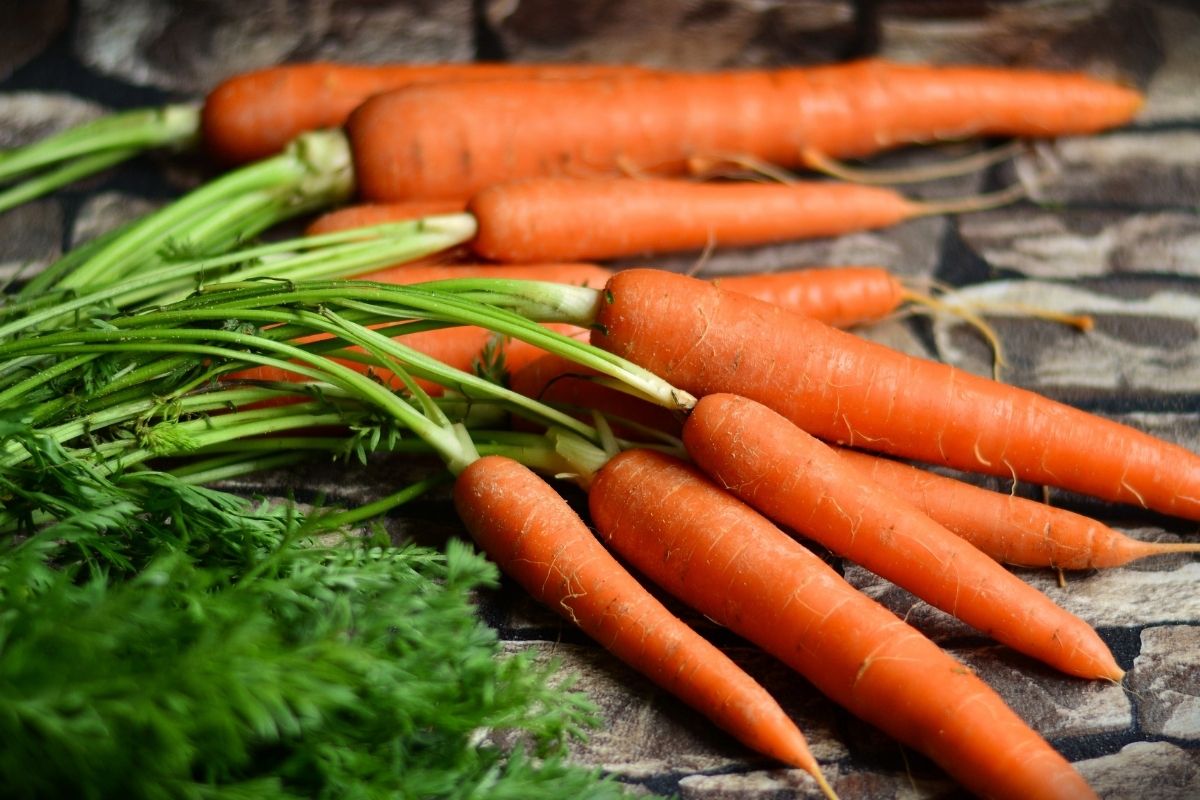
Carrots grow in a variety of colors, including orange and purple. The orange-colored carrot is the best known and most common variety grown today.
Carrots can be eaten raw or cooked. They have a mild flavor that is best when they are young. The skin should be removed before cooking to avoid bitterness.
Carrots can be used as an ingredient in salads, soups, stews, and casseroles.
2. Pumpkin

Pumpkins are famous thanks to celebrations like Halloween. The pumpkin is a large orange vegetable with a thick rind and a fleshy inside.
Pumpkin flesh tastes slightly sweet and can be made into delicious soups, or the popular dessert, pumpkin pie.
Pumpkins grow over the summer and should be harvested in the fall. As pumpkins are part of the squash family, you can find a large variety of pumpkins in different shapes and colors.
Pumpkins take around 120 days to grow from seed. This depends on the variety of pumpkin you have chosen.
A ripe pumpkin should have its full color and a woody stem. When the pumpkin is mature and it’s ready to be harvested, you just need to cut off the pumpkin from the stem.
The seeds from pumpkins are also edible. Roast them for snacks, add them to bread, or use them as a garnish on desserts.
3. Sweet Potatoes

Sweet potatoes are another type of potato native to Central America. They are usually yellow-orange, but some varieties may be white, red, pink, or purple.
They are very similar to regular potatoes, except that their skin is much thicker and smoother. Sweet potatoes are often served at Thanksgiving dinner because of this similarity.
They are high in vitamin A and potassium, and low in calories. Sweet potatoes are believed to support weight loss thanks to their many nutrients.
Sweet potatoes are easy to prepare. Peel them, boil them until tender, then mash them. You can serve them plain or with butter, cream cheese, sour cream, or even peanut butter!
The high mineral content of these root vegetables means that they are ideal for people who suffer from cholesterol, high blood pressure, and diabetes.
Thanks to their high potassium content, sweet potatoes can make up 12% of your daily intake of potassium.
4. Orange Beetroot

Beets are members of the beet family, which includes spinach, chard, Swiss chard, turnip greens, etc.
Beets come in two main types: the popular red and a more unusual golden. Red beets are more commonly available than golden ones.
There is no large difference between the two beetroot types, other than their color. Golden beets are a little milder in taste.
However, the orange beet variety is also less sweet than its red counterpart. Both types are good sources of vitamins C and K, folate, iron, calcium, fiber, and antioxidants.
You can eat beetroot raw, boiled, roasted, sautéed, pickled, or juiced. Beets are great in salads, soups, and side dishes.
5. Butternut Squash
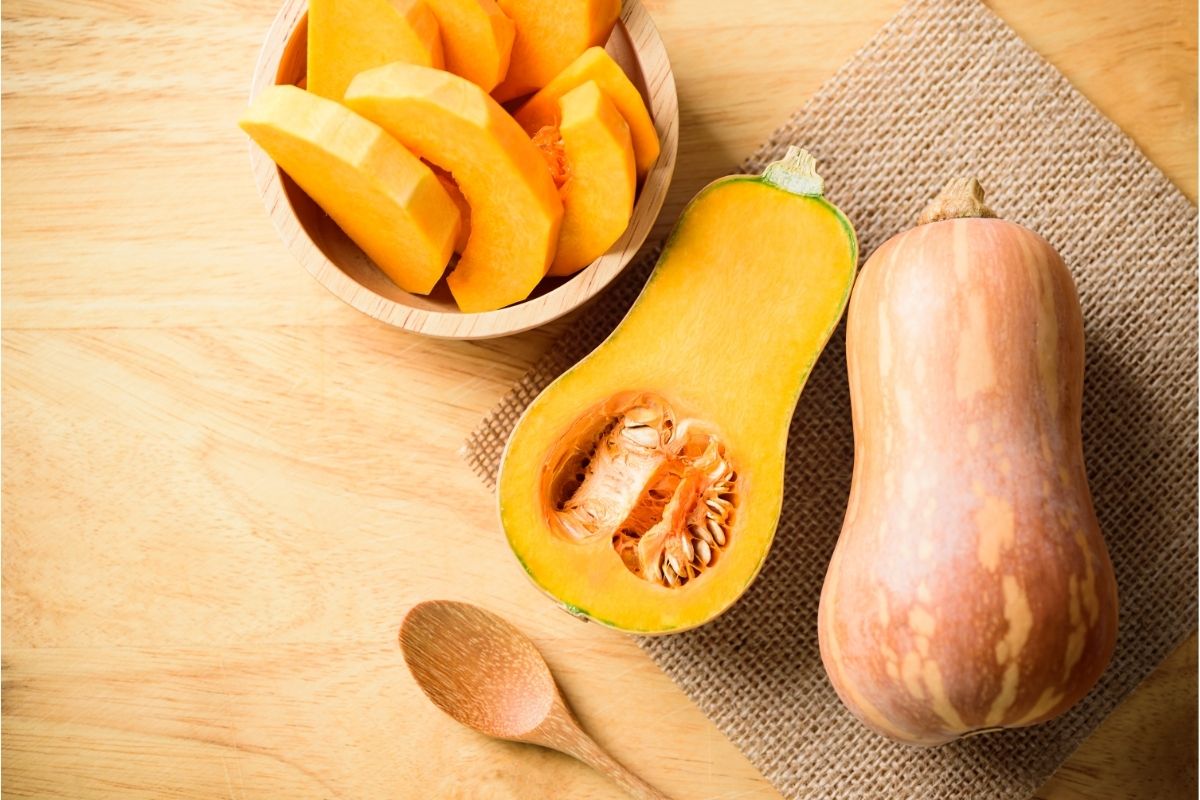
Butternut squash is part of the winter squashes. Winter squashes come in many types and sizes.
Some examples include acorn squash, delicata squash, kabocha squash, hubbard squash, spaghetti squash, and zucchini.
These vegetables are all members of the gourd family, which includes cucumbers and melons.
Known also as butternut pumpkins in New Zealand and Australia, this orange vegetable grows on a vine on the ground. This is similar to pumpkins.
Butternut squashes have a hard outer rind and an orange-colored inner flesh that tastes slightly sweet and nutty.
One of the most underrated orange foods, butternut squash is classed as a superfood ideal for cold winter weather.
It contains a large number of carbohydrates as well as plenty of antioxidants, fiber, and vitamins.
You can eat butternut squash raw but it tastes much more delicious when cooked as part of a salad or soup.
6. Orange Pepper

Peppers come in many colors and flavors. Some of the most common ones are green bell peppers, red bell peppers, yellow bell peppers, orange bell peppers, chili peppers, and jalapeno peppers.
Bell peppers are one of the most popular fruits in the world. They are used both fresh and cooked.
Bell peppers contain lots of vitamin C, vitamin B6, folate, niacin and thiamine. All of these vitamins are essential for healthy eyesight and good health.
In addition to being delicious, oranges are also nutritious. They provide you with vitamin C, calcium, iron, and phosphorus.
Bell peppers are also rich in beta carotene, lycopene, and lutein. These three substances help protect against certain cancers such as prostate cancer and breast cancer.
Orange peppers are grown mostly in Mexico, South Africa, India, China, and Thailand.
7. Acorn Squash
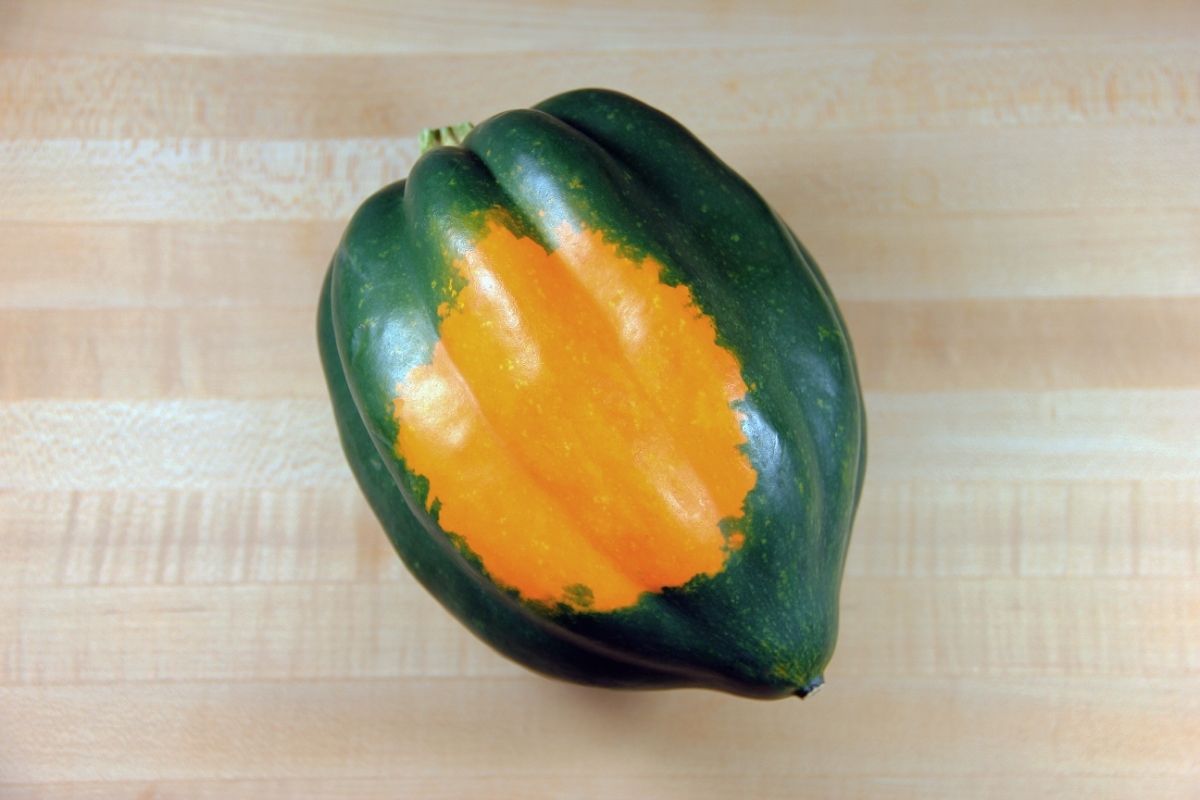
Acorn squash is a member of the pumpkin family. This winter squash has thick orange skin and a soft, fleshy interior.
Although acorn squashes are often called winter squash, they belong to the same family as summer squashes.
While acorn squashes are very similar to pumpkins, they have a lighter stem than pumpkins. Their shape resembles a large acorn.
Acorn squashes come in a variety of colors. Most acorn squashes have a dark green color with some yellow and orange patches.
This orange and green vegetable can weigh up to two pounds when matured, and it can be easily stored outside the fridge over winter.
You can grow acorn squashes from early spring until the first frosty nights in fall.
8. Orange Dorset Naga Chili
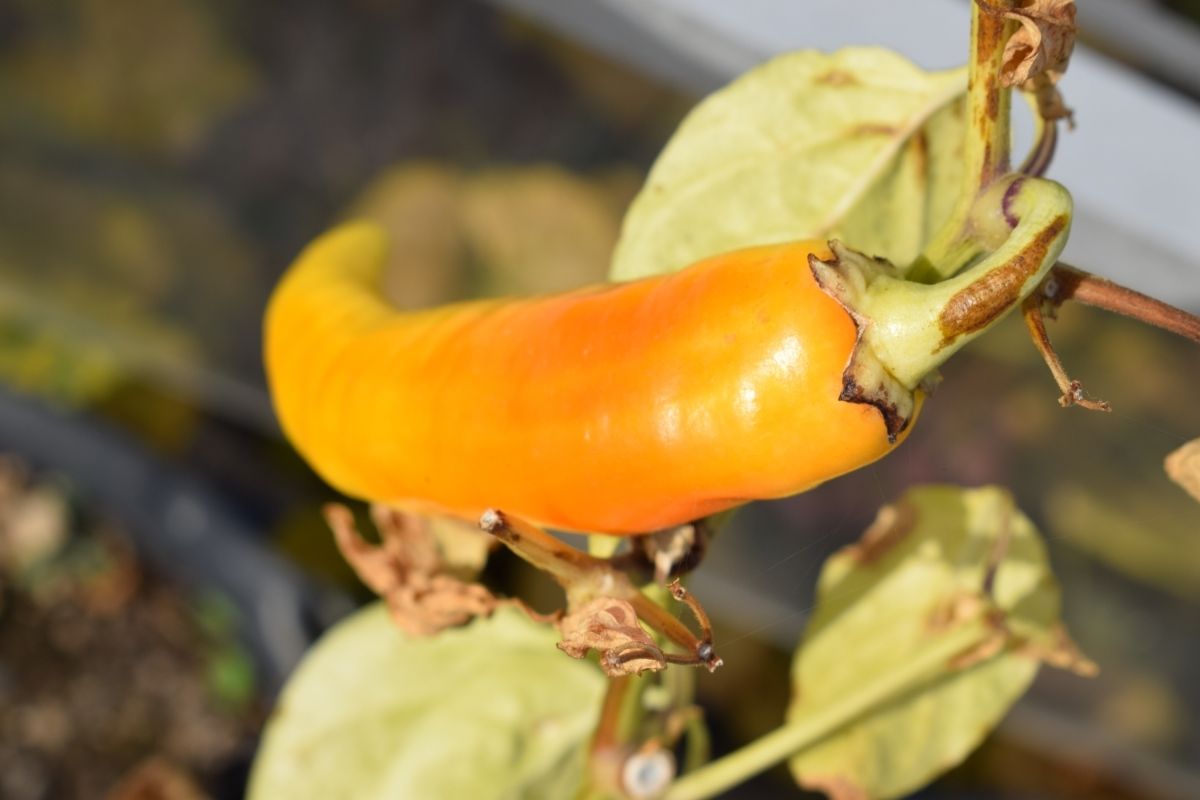
The Dorset Naga chili pepper is an orange variety of the Naga Morich chili which is grown in parts of South Asia.
The Dorset Naga chili generally has a very high heat level with over a million Scoville heat units. However, the orange-colored variety is slightly milder and tastes sweet.
Most specialist growers refer to this chili as part of the “superhots”. These chilies are some of the hottest varieties in the world.
9. Oca Giggles
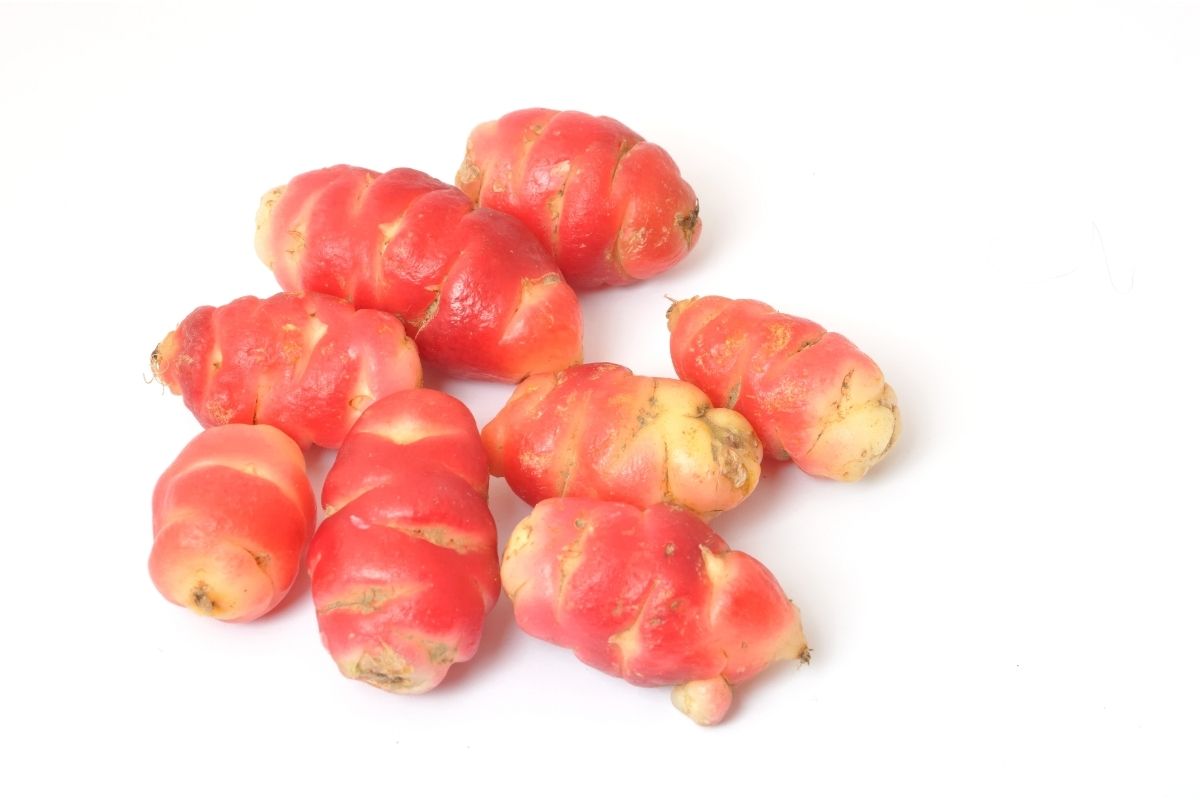
Also known as Peruvian wood sorrel, this unusual vegetable grows in South America. Oca giggles can be pink, red, or orange.
This versatile root is ideal for adding some exotic flavor to hot dishes and salads. It tastes slightly tangy and this is perfect for most dishes.
Oca giggles can be grown in raised beds or containers. It is frost sensitive so will need to be inside over the cold winter months, but it also grows well in the greenhouse all year round.
10. Turmeric Root
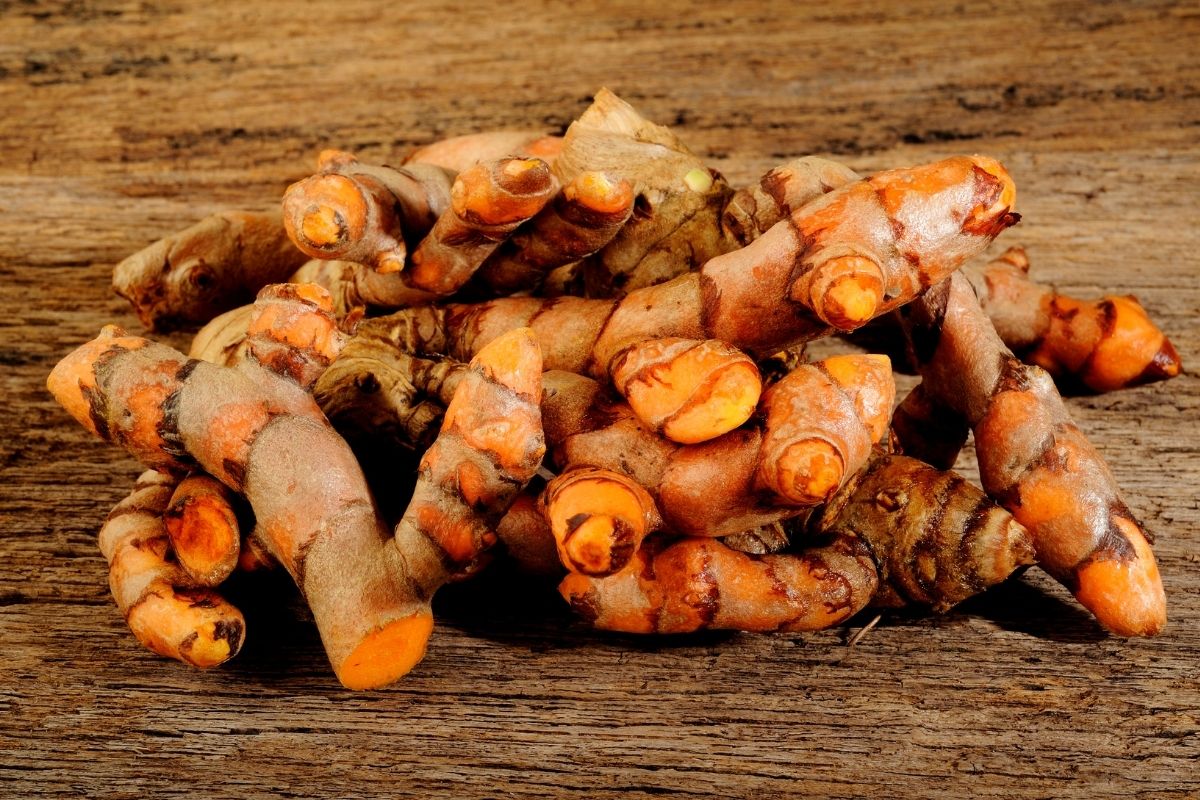
Not strictly classified as part of the orange vegetables, turmeric root is used as a spice for many meals. It is known as Indian saffron as it grows mostly in India and parts of South Asia.
The roots of this plant are harvested during the dry season between September and October. The dried roots are then sold at local markets, or processed into a powder.
Turmeric is usually sold in powder form in supermarkets, although there has been an increase in using turmeric root as a vegetable.
The best way to use turmeric root is to add it to your cooking. You can use it in curries, soups, rice dishes, and stews.
Turmeric is also a famous herbal medicine used for treating inflammatory diseases such as arthritis and other illnesses.
Frequently Asked Questions
Get your last-minute queries answered here!
What Is The Healthiest Orange Vegetable?
According to the USDA National Nutrient Database, the healthiest orange vegetable is the sweet potato. Sweet potatoes contain more vitamin A than any other orange vegetable.
They also contain more potassium and fiber than any other orange vegetable and are one of the few fruits that contain no cholesterol.
Sweet potatoes are rich in nutrients like vitamin C, iron, magnesium, zinc, phosphorus, niacin, riboflavin, and folate.
How Can I Grow My Own Orange Vegetables?
If you live in a warmer climate, you may be able to grow orange vegetables throughout the year. In cooler climates, they may not survive the cold winter and frost.
What Is The Benefit Of Eating Orange Vegetables Such As Carrots?
Carrots have long been associated with good eyesight. They are believed to help improve vision by improving blood flow to the back of the eye.
In addition, carrots are loaded with beta-carotene, which helps protect against cancer. Beta-carotene is converted into vitamin A in the body.
Is Turmeric A Vegetable?
Yes, turmeric is a type of herb. It belongs to the ginger family and has a similar appearance to ginger.
It is native to tropical regions of Southeast Asia and India.
Are Orange Vegetables Good For Losing Weight?
Some orange vegetables can support the digestive system and improve how your body processes food. A better digestion means you get more energy from your orange foods and store less fat.
Final Thoughts
Not only orange fruit such as oranges, mango, and papaya are very popular, but orange vegetables can also add a dash of color to your meals.
While orange peppers are ideal for salads, pumpkins and squashes make an excellent base for a delicious soup.
Editor’s Recommendations
13 Awesome Orange Trees (Including Pictures)







